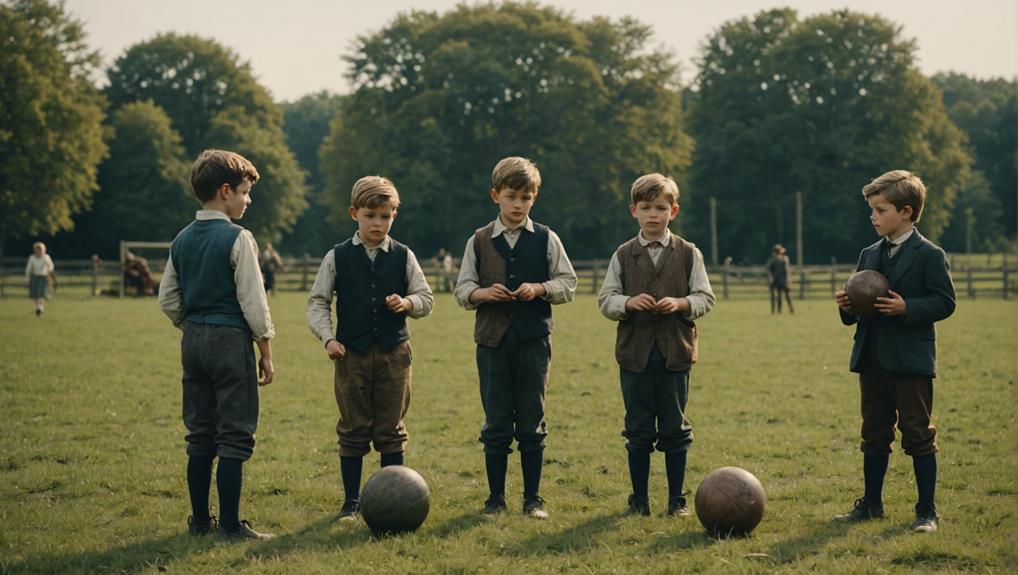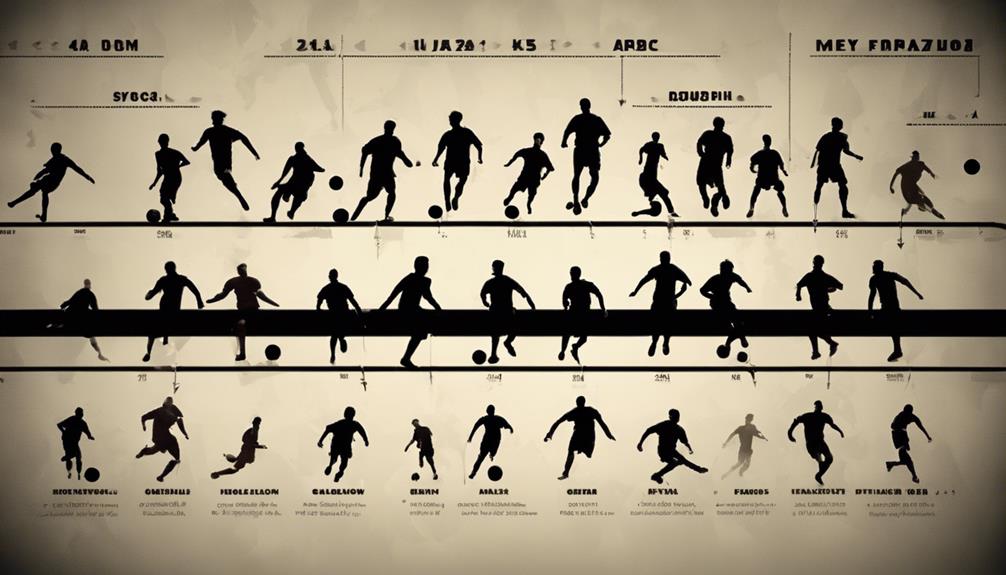
The Origins of Soccer: Who Invented It?
April 25, 2024Soccer wasn't invented by just one person; it evolved from ancient ball games played worldwide. Various civilizations like China, Greece, and Rome had similar games that inspired modern soccer and rugby. Over time, different traditions from countries like Japan and Scotland influenced the sport's development. In 1863, the Football Association was established in Britain, marking a pivotal moment in soccer's history. The term 'soccer' emerged later in England to distinguish it from rugby. Explore the rich origins and evolution of soccer to uncover its fascinating journey from the past to the present.
Early Forms of Soccer in Ancient Times
Ancient civilizations across the globe engaged in various ball games that laid the foundation for modern soccer. In ancient China, the game of Cuju involved kicking a leather ball through a target without it touching the ground, showcasing early forms of kicking a ball for sport.
The Greeks, Romans, Egyptians, and even Native Americans also played their versions of ball games, incorporating elements of hands, feet, and sticks. The Roman game of Harpastum and the Greek game of Episkyros had similarities to what would later become rugby and soccer.
These diverse ancient traditions of foot-focused games like Japan's Kemari and Scotland's Ba game contributed to the evolution of soccer as it's today. Soccer's origins can be traced back to these early forms of ball games played by ancient civilizations, highlighting the universal appeal and longevity of kicking a ball for entertainment and competition.
Evolution of Modern Soccer in Britain
Modern soccer in Britain underwent significant transformation from its folk football roots during the medieval era to the structured and standardized sport we recognize today.
The evolution of soccer in Britain was greatly influenced by the establishment of the Football Association in 1863, which sought to standardize the rules of the game across the country. By the 1870s, most regions in Britain had adopted agreed-upon rules for playing soccer, paving the way for the modern game.
The term 'soccer' emerged in the 1880s in Britain to differentiate association football from rugby football. As soccer became more organized and standardized, it also turned professional, with clubs starting to pay players.
This shift to professionalism fueled the growth and development of soccer in Britain, laying the foundation for the sport's popularity and success in the country. The establishment of the Football Association played a pivotal role in shaping the trajectory of soccer in Britain, setting the stage for its continued evolution as a beloved sport.
Establishment of the Football Association

The establishment of the Football Association on October 26, 1863, in London, England marked a significant turning point in the history of soccer in Britain. Its formation aimed to unify and standardize the rules of soccer across different regions in Britain.
At the FA's inaugural meeting, representatives from leading soccer clubs came together to codify the game, leading to the official recognition and organization of soccer as a sport. The efforts of the Football Association resulted in the gradual adoption of common rules, including the ban on carrying the ball, shaping modern soccer.
Emergence of the Term 'Soccer'
Originally coined in England in the 1880s, the term 'soccer' emerged as a distinctive identifier for association football, setting it apart from rugby football. Here are some interesting points about the emergence of the term 'soccer':
- The term 'soccer' derived from the word 'association football' commonly used in Britain, reflecting the sport's organized nature.
- 'Soccer' gained popularity rapidly, especially as it described a sport that combined elements of rugby and association football, providing a clear distinction.
- While gridiron football found success in the United States, soccer continued to grow globally, attracting a diverse and widespread following.
- Initially, the term 'soccer' was primarily used in the United States to refer to the sport, showcasing the different preferences in terminology between regions.
The evolution of the term 'soccer' highlights the sport's origins, the influence of different variations of football, and its journey towards becoming a global phenomenon.
Soccer's Global Evolution

Soccer's global evolution can be traced back to ancient ball games in various cultures, but its modern form emerged in 19th century England, setting the stage for its widespread popularity across continents. The establishment of the English Football Association in 1863 was a pivotal milestone in the standardization and development of soccer as a modern sport. As the game spread beyond Britain, it was carried by schoolteachers and immigrants, leading to its embrace in Europe, the Americas, and beyond. Soccer leagues and competitions proliferated globally, with FIFA now governing 211 national associations and organizing prestigious events like the FIFA World Cup.
The global appeal of soccer is unmistakable, with over 240 million players worldwide and a vast network of clubs, leagues, and international competitions. This diverse following underscores soccer's ability to transcend cultural boundaries and unite people from all walks of life in their shared passion for the beautiful game.
Soccer's Roots in Ancient China
In ancient China, the game of Cuju emerged during the Han Dynasty, showcasing early elements of what would become modern soccer. Players aimed to kick a leather and feather ball through a target without letting it touch the ground, emphasizing kicking skills and ball control.
This ancient Chinese sport laid the foundation for the development of soccer as it's understood today.
Ancient Chinese Ball Game
The ancient Chinese ball game known as Cuju, dating back to the Han dynasty, serves as a foundational precursor to modern soccer.
Cuju, an early form of soccer in ancient China, involved kicking a leather ball through a goal with skilled footwork and agility. This game emphasized the importance of precision and control, reflecting the deep roots of soccer in Chinese culture.
The leather and feather ball used in Cuju highlights the ancient origins of this sport and how it has evolved over time. The term 'Cuju,' translating to 'kick ball,' encapsulates the essence of this historical game that laid the groundwork for the beloved sport of soccer today.
- Cuju showcases early soccer skills with its focus on footwork and agility.
- The leather ball used in Cuju highlights the ancient roots of soccer in China.
- The term 'Cuju' translates to 'kick ball,' reflecting the fundamental nature of the game in ancient Chinese culture.
- Cuju was a stylized version of keepy-uppies, emphasizing precision and control.
Influence on Modern Soccer
With its origins dating back to the Han dynasty, ancient Chinese Cuju greatly influenced the development of modern soccer. Cuju, an ancient Chinese form of soccer, emphasized ball control skills and kicking techniques. Players had to kick a leather and feather ball through a target without letting it touch the ground, showcasing early ball control abilities.
This stylized game of keepy-uppies, played without the use of hands, was popular among both commoners and nobility in ancient China. The precise footwork and technique required in Cuju laid the foundation for the ball control and kicking skills seen in modern soccer today.
The influence of Cuju on the origins of soccer is evident in the emphasis on skillful play and strategic maneuvering that define the sport worldwide.
Influence of Marn Gook in Australia

Marn Gook's influence in Australia played a significant role in shaping the development of soccer in the country. The game's emphasis on foot skills and precision mirrored key aspects of modern soccer, showcasing a historical link to indigenous ball game traditions.
Understanding Marn Gook's impact provides insight into the rich historical background of soccer's evolution in Australia.
Marn Gook's Impact
Having roots in traditional Indigenous Australian culture, Marn Gook's impact on sports in Australia is profound and enduring.
- Marn Gook was a significant traditional Indigenous Australian game akin to cuju, involving kicking a ball.
- It served as both a recreational activity and a form of cultural expression within Aboriginal communities.
- The game highlighted the early presence of ball games in Australian indigenous cultures, showing the timeless appeal of such sports.
- Marn Gook's influence continues to resonate in the history of Indigenous Australian sports, adding to the diverse array of traditional games and activities in Aboriginal communities.
Soccer Development in Australia
Indigenous Australian sporting traditions, such as Marn Gook, have played a significant role in shaping the development of soccer in Australia.
Marn Gook, an indigenous Australian kicking game, shares similarities with the ancient Chinese game of Cuju. Players kicked a possum fur ball through goalposts, emphasizing agility, skill, and teamwork. This early form of soccer highlights indigenous Australians' historical engagement in soccer-like activities, showcasing the rich sporting heritage in Australia.
Marn Gook exemplifies the universal appeal of ball games across cultures, contributing to the roots of soccer's development worldwide. The game's focus on teamwork and skill demonstrates how indigenous Australian practices have influenced the evolution of soccer in Australia and beyond.
Soccer's Development in America
Soccer's development in America began in the late 19th century with the introduction of the sport by European immigrants and schoolteachers. The United States Soccer Football Association (USSFA) was established in 1913 to oversee the growth of soccer in America.
The founding of the North American Soccer League (NASL) in 1968 marked a significant milestone in American soccer history, bringing more attention to the sport. Major League Soccer (MLS) was launched in 1996, providing a professional platform for soccer in the United States and further solidifying its presence.
The success of the US Men's National Team in the 1930 World Cup and the Women's National Team in various competitions have played pivotal roles in enhancing the popularity and development of soccer in America. The establishment of these leagues and the achievements of national teams have contributed to the steady rise of soccer as a beloved sport within the American sports landscape.
Oldest Soccer Club in the World

With a rich history dating back to the mid-19th century, the Oldest Soccer Club in the World holds a prestigious title in the domain of organized soccer. Notts County, founded in 1862, is widely acknowledged as the oldest professional association football club globally.
Cray Wanderers, established in 1860, shares a historical legacy as one of the oldest soccer clubs alongside Hallam FC, which was founded in 1857 in Sheffield and is considered the oldest soccer club worldwide. Hallam FC's ground, Sandygate, is recognized by the Guinness World Records as the Oldest Football Ground.
These historical soccer clubs, including Notts County, Cray Wanderers, and Hallam FC, showcase the rich tradition and longevity of organized soccer, providing a glimpse into the roots of the sport dating back to the mid-19th century. The legacy of these clubs underscores their significant role in shaping the history of soccer as it's understood today.
Impact of FIFA on International Soccer
FIFA has played a pivotal role in shaping international soccer, exerting a significant global influence on the sport.
Through fostering cross-border football diplomacy, FIFA has facilitated collaboration and competition among nations, elevating the standard of play worldwide.
The organization's efforts in standardizing rules and organizing prestigious tournaments have been fundamental in promoting unity and growth within the soccer community.
Fifa's Global Influence
Since its establishment in 1904, FIFA has wielded significant influence on the international soccer landscape through its oversight of global tournaments and events. This influence is evident in various ways:
- Global Presence: With 211 member associations worldwide, FIFA's reach extends to every corner of the world.
- Premier Tournaments: FIFA organizes prestigious events like the FIFA World Cup, engaging audiences globally.
- Club Competitions: The FIFA Club World Cup highlights FIFA's impact beyond national teams, showcasing top clubs from around the globe.
- Central Hub: Operating from its headquarters in Zurich, FIFA serves as a central hub for coordinating international soccer activities, fostering unity and collaboration among diverse soccer communities.
Cross-Border Football Diplomacy
Playing a pivotal role in fostering cross-border relations, international soccer diplomacy driven by FIFA has become a powerful tool for global unity and cooperation. FIFA, through international soccer competitions like the World Cup, promotes cultural exchange and enhances cross-border cooperation.
With 211 national associations under its umbrella, FIFA's influence in global promotion and soccer diplomacy is significant. The organization's initiatives, such as the FIFA Forward Program, focus on development projects that have a positive social impact worldwide.
Conclusion
Now that you know the origins of soccer, you can appreciate the rich history and evolution of this beloved sport.
By understanding how early forms of the game have transformed into the modern version that's familiar to us today, you can truly appreciate the cultural significance and global impact of soccer.
Keep exploring the fascinating history of soccer to deepen your enjoyment and appreciation for the beautiful game.

